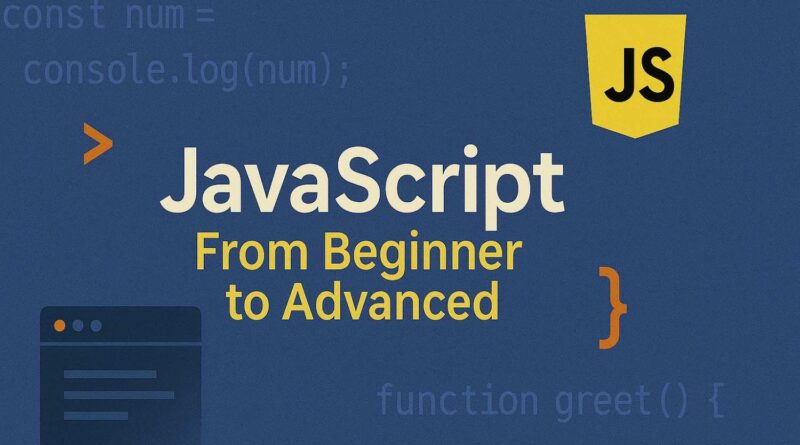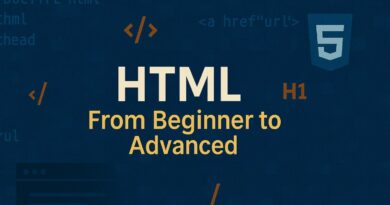Mastering JavaScript: From Absolute Beginner to Advanced
📚 Mastering JavaScript from Scratch: A Complete Guide for Beginners to Advanced 🚀
Mastering JavaScript is a versatile, high-level programming language primarily used to create interactive effects within web browsers. It enables dynamic content updates, control of multimedia, animated images, and much more.
Setting Up Your Development Environment
To start coding in JavaScript, you’ll need:
-
Text Editor: Visual Studio Code is highly recommended.
-
Web Browser: Modern browsers like Chrome or Firefox come with built-in developer tools.
Example:
JavaScript Basics
Variables and Data Types
Variables store data values. Use let, const, or var to declare variables.
Example:
Data Types:
-
String: Textual data (
"Hello"). -
Number: Numeric data (
100). -
Boolean:
trueorfalse. -
Null: Intentional absence of value.
-
Undefined: Variable declared but not assigned.
-
Object: Collections of key-value pairs.
-
Array: Ordered list of values.
Operators
Operators perform operations on variables and values.
-
Arithmetic Operators:
+,-,*,/,% -
Assignment Operators:
=,+=,-= -
Comparison Operators:
==,===,!=,!==,>,<,>=,<= -
Logical Operators:
&&,||,!
Control Structures
Conditional Statements
Control the flow of execution based on conditions.
Example:
Loops
Execute a block of code multiple times.
For Loop Example:
While Loop Example:
Functions and Scope
Functions
Reusable blocks of code that perform a specific task.
Example:
Arrow Functions
A concise syntax for writing functions.
Example:
Scope
Determines the accessibility of variables.
-
Global Scope: Accessible anywhere.
-
Local Scope: Accessible within a function or block.
Objects and Arrays
Objects
Collections of key-value pairs.
Example:
Arrays
Ordered lists of values.
Example:
DOM Manipulation
The Document Object Model (DOM) represents the structure of a web page. JavaScript can manipulate the DOM to change content dynamically.
Example:
Event Handling
JavaScript can respond to user interactions through events.
Example:
Asynchronous JavaScript
JavaScript can handle asynchronous operations using callbacks, promises, and async/await.
Callbacks
Functions passed as arguments to other functions.
Example:
Promises
Represent the eventual completion of an asynchronous operation.
Example:
Async/Await
Syntactic sugar over promises for cleaner asynchronous code.
Example:
Advanced Concepts
Closures
Functions that have access to variables from another function’s scope.
Example:
Prototypes
JavaScript uses prototypes for inheritance.
Example:
Error Handling and Debugging
Handle errors gracefully using try-catch blocks.
Example:
Working with APIs
JavaScript can fetch data from APIs using the Fetch API.
Example:
JavaScript in the Browser
JavaScript can interact with browser-specific objects:
-
Window Object: Represents the browser window.
-
Navigator Object: Contains information about the browser.
-
Location Object: Contains information about the current URL.
Example:
Promises
Async/Await
⚙️ JavaScript in the Browser
Browser objects:
-
window -
navigator -
location
Also Read,
HTML Programming Language: Absolute Beginners to Advanced
CSS Web Development: From Basics to Advanced for Beginners
📚 JavaScript in the Real World
Projects You Can Build:
-
To-Do List
-
Calculator
-
Quiz App
-
Form Validator
-
Weather App (API)
⚒️ Tools and Frameworks
-
Node.js – Server-side JS
-
React, Vue, Angular – UI Frameworks
-
Webpack, Babel – Build tools
✅ Advantages of JavaScript
-
🖥️ Runs in all browsers
-
⚡ Fast & responsive
-
🔄 Integrates with other tech easily
-
🌍 Huge community
-
🤖 Full stack capabilities (with Node.js)
❌ Disadvantages of JavaScript
-
🧪 Inconsistent browser support
-
🔐 Exposed client-side code
-
🧩 Asynchronous nature is tricky
-
❌ Overuse can slow websites
-
📚 Learning curve for advanced features
📋 Best Practices
-
Use
letandconst -
Use strict equality
=== -
Modularize your code
-
Avoid global variables
-
Handle exceptions properly
📘 External Resources
🎯 Final Thoughts
JavaScript is essential for any web developer. With continuous practice and real-world projects, you’ll be equipped to build anything from websites to full-stack applications.
📢 If you found this helpful, share it and subscribe for more hands-on coding tutorials!
📤 Stay Updated with NextGen Careers Hub
📱 Follow us on Instagram
📺 Subscribe us on YouTube
Please share our website with others: NextGenCareersHub.in






Comments are closed.